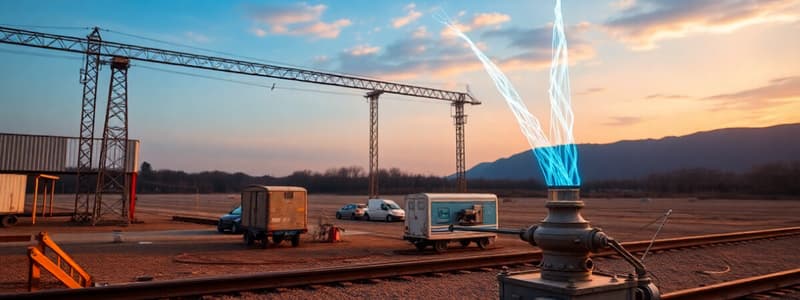Podcast
Questions and Answers
The formula for work is W = F × d × cos(θ), where θ represents the angle between the force and the direction of ______.
The formula for work is W = F × d × cos(θ), where θ represents the angle between the force and the direction of ______.
motion
One Joule is defined as 1 Newton multiplied by 1 ______.
One Joule is defined as 1 Newton multiplied by 1 ______.
meter
Kinetic Energy (KE) is the energy of an object in ______.
Kinetic Energy (KE) is the energy of an object in ______.
motion
Work is done when a force causes an object to move in the direction of the ______.
Work is done when a force causes an object to move in the direction of the ______.
The formula for Potential Energy (PE) is PE = m × g × ______.
The formula for Potential Energy (PE) is PE = m × g × ______.
According to the Law of Conservation of Energy, energy cannot be created or ______.
According to the Law of Conservation of Energy, energy cannot be created or ______.
Power is defined as the rate at which work is done or energy is ______.
Power is defined as the rate at which work is done or energy is ______.
The work-energy theorem states that the work done on an object equals the change in its ______.
The work-energy theorem states that the work done on an object equals the change in its ______.
The SI unit for power is ______.
The SI unit for power is ______.
Efficiency is the ratio of useful work output to total energy ______.
Efficiency is the ratio of useful work output to total energy ______.
Flashcards are hidden until you start studying
Study Notes
Work
- Definition: Work is done when a force causes an object to move in the direction of the force.
- Formula: Work (W) = Force (F) × Distance (d) × cos(θ)
- θ = angle between the force and the direction of motion.
- Units:
- SI unit: Joule (J)
- 1 Joule = 1 Newton × 1 meter
- Conditions for Work:
- A force must be applied.
- The object must move.
- Movement must be in the direction of the force or have a component in that direction.
Energy
- Definition: Energy is the capacity to do work.
- Units:
- SI unit: Joule (J)
- Types of Energy:
- Kinetic Energy (KE): Energy of an object in motion.
- Formula: KE = 0.5 × m × v²
- m = mass (kg)
- v = velocity (m/s)
- Formula: KE = 0.5 × m × v²
- Potential Energy (PE): Energy stored in an object due to its position or configuration.
- Formula: PE = m × g × h
- g = acceleration due to gravity (approx. 9.8 m/s²)
- h = height (m)
- Formula: PE = m × g × h
- Kinetic Energy (KE): Energy of an object in motion.
Law of Conservation of Energy
- Principle: Energy cannot be created or destroyed, only transformed from one form to another.
- Implication: The total energy in an isolated system remains constant.
Power
- Definition: Power is the rate at which work is done or energy is transferred.
- Formula: Power (P) = Work (W) / Time (t)
- Units:
- SI unit: Watt (W)
- 1 Watt = 1 Joule/second
Practical Examples
- Work Done Against Gravity: Lifting an object requires work against gravitational force.
- Energy Transformations: A falling object converts potential energy to kinetic energy.
- Mechanical Energy: The sum of kinetic and potential energy in a system.
Important Concepts
- Work-Energy Theorem: The work done on an object equals the change in its kinetic energy.
- Efficiency: Ratio of useful work output to total energy input, often expressed as a percentage.
These notes provide a concise overview of work and energy concepts relevant to class 9 physics.
Work
- Definition: Work occurs when a force acts on an object, causing it to move in the direction of the force.
- Formula: Work is calculated as ( W = F \times d \times \cos(θ) ), where ( θ ) is the angle between the force and the direction of motion.
- Units:
- Work is measured in Joules (J).
- One Joule equals the work done when one Newton of force moves an object one meter.
- Conditions for Work:
- A force must be applied to the object.
- The object must experience movement.
- Movement should be in the direction of the force or at least have a component directed along that line.
Energy
- Definition: Energy represents the capacity to perform work.
- Units: Energy is also measured in Joules (J).
- Types of Energy:
- Kinetic Energy (KE): The energy of motion, given by the formula ( KE = 0.5 \times m \times v² ), where ( m ) is mass in kilograms and ( v ) is velocity in meters per second.
- Potential Energy (PE): The stored energy based on an object's position or configuration, calculated as ( PE = m \times g \times h ), with ( g ) being the acceleration due to gravity (approximately 9.8 m/s²) and ( h ) the height in meters.
Law of Conservation of Energy
- Principle: Energy is neither created nor destroyed; it simply changes from one form to another.
- Implication: In an isolated system, the total energy remains constant over time.
Power
- Definition: Power represents the rate at which work is done or energy is transferred.
- Formula: Power can be calculated as ( P = W / t ), where ( W ) is work done and ( t ) is time.
- Units:
- Power is measured in Watts (W).
- One Watt is equivalent to one Joule per second.
Practical Examples
- Work Against Gravity: Lifting an object involves doing work against gravitational force.
- Energy Transformations: A falling object transforms potential energy into kinetic energy as it descends.
- Mechanical Energy: The total mechanical energy in a system is the sum of its kinetic and potential energy.
Important Concepts
- Work-Energy Theorem: States that the work done on an object is equal to the change in its kinetic energy.
- Efficiency: Defined as the ratio of useful work output to the total energy input, often expressed as a percentage.
Studying That Suits You
Use AI to generate personalized quizzes and flashcards to suit your learning preferences.




